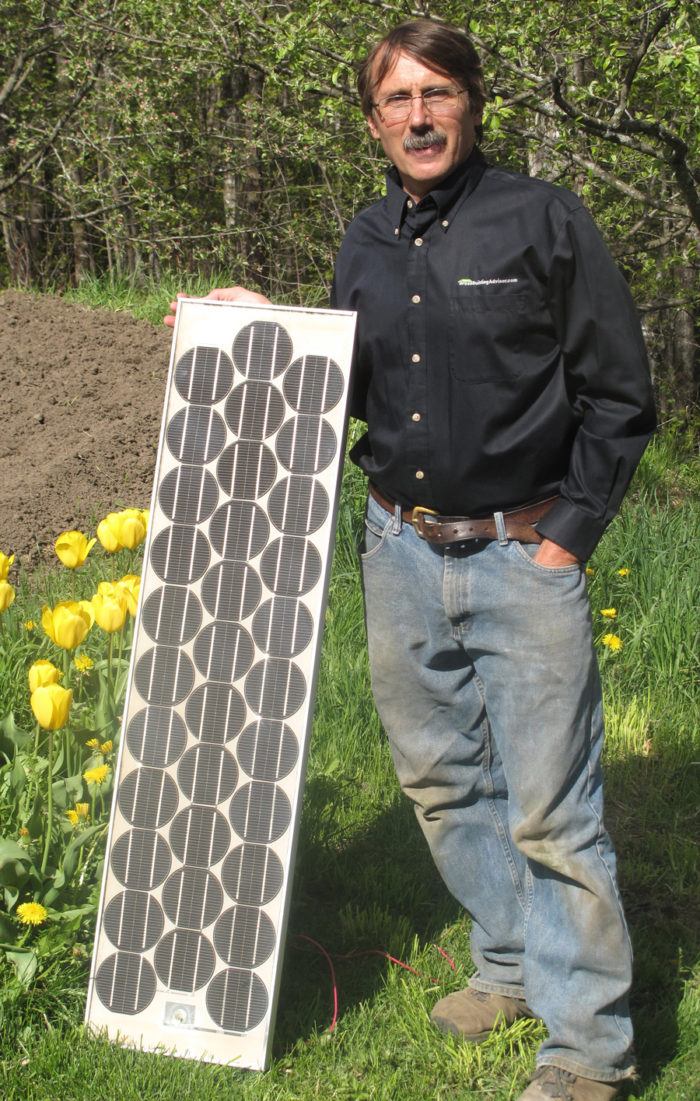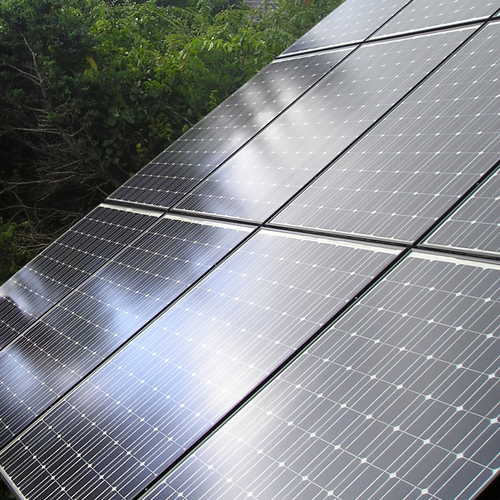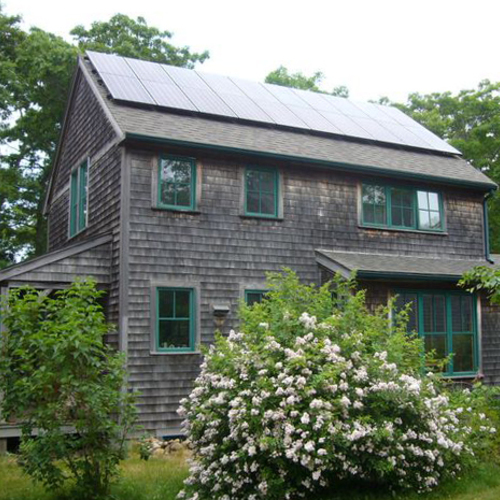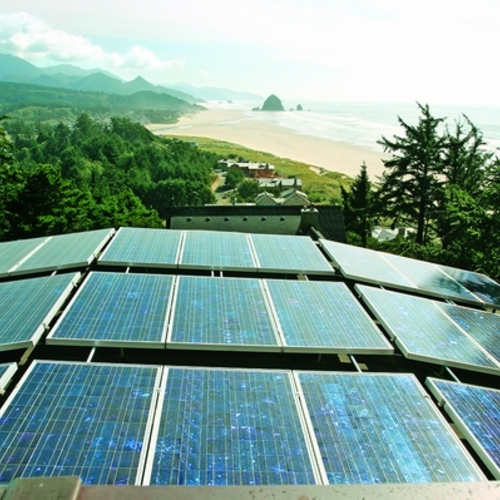
Image Credit: Noah Manning
In 1980, after living in the woods of Vermont without electricity for five years, I bought my first photovoltaic (PV) module. Responding to a small ad in Mother Earth News, I sent a check to Joel Davidson, a back-to-the-land urban refugee who was facilitating a bulk purchase of PV panels. From his off-grid acreage in Pettigrew, Arkansas, Davidson was selling 33-watt Arco Solar modules for $275 each.
Many people ask, “How long do solar panels last?” To mark the 30th anniversary of my first PV module, I decided to climb up on my roof and bring it down for testing.
My Arco Solar panel (model 16-2000) was manufactured at a plant in Chatsworth, California. The module was designed to charge a 12-volt battery at a maximum voltage of about 16 VDC. When new, the 33-watt module produced 2.0 amps in full sunlight.
After being exposed to the weather for 30 years, how’s the old Arco module working now?
Better than factory specs
I decided to test my old PV module by connecting it directly (with no intervening battery) to two different 12-volt loads: a 35-watt incandescent light bulb, and a blower rated at 4.5 amps (about 54 watts).
I ran the test in my backyard, on a sunny day at about 11:30 a.m. The outdoor temperature was about 50°F.
The old PV module passed with flying colors. It easily powered up the light bulb; my Fluke multimeter showed that under a full load of 2.015 amps, the module’s voltage was an impressive 14.93 volts.
Cranking out 2.5 amps in full sunlight
The next test was more challenging: I hooked up the 54-watt blower directly to the panel. Wow! The blower started spinning at a fast clip. According to the Fluke multimeter, the blower was drawing 2.5 amps from my ancient solar panel — more power than would be…
Weekly Newsletter
Get building science and energy efficiency advice, plus special offers, in your inbox.

This article is only available to GBA Prime Members
Sign up for a free trial and get instant access to this article as well as GBA’s complete library of premium articles and construction details.
Start Free TrialAlready a member? Log in















17 Comments
Cost of PV
Martin,
I plugged your $275 figure into the Consumer Price Index Inflation Calculator:
http://data.bls.gov/cgi-bin/cpicalc.pl
Adjusting for inflation (or loss of purchasing power), it comes out to $727.58 in 2010 dollars (USD).
That's almost enough to purchase one of SolarWorld's 230 watt panels here:
http://www.wholesalesolar.com/products.folder/module-folder/SolarWorld/SolarWorld230.html
Here's another way to look at the numbers. You paid $8.33 / watt in 1980. Using the inflation calculator, the SolarWorld 230 panel is selling for $1.30 / watt in 1980s dollars.
The cost of PV has certainly come down, but I think it's safe to say it will never be cheap.
Value? Now that's a different topic . . . .
Regards - Daniel
Actually, PV is already cheaper than "conventional" electricity
Daniel - you say that "it is safe to say that solar will never be cheap". Let's do the math:
Today, in California, we are installing complete PV systems for homes in the range of $6.50 per peak watt. That is BEFORE any rebates or tax credits. If these newer, improved modules perform as well as the older Arco module that Martin tested, and we can expect 40 years of good performance from them, then my calculations using PVWatts shows an annual production of about 1,500 w-hr per peak watt of module (this includes all of the derating factors, such that I would expect 0.82 Wh per Wp).
see http://rredc.nrel.gov/solar/calculators/PVWATTS/version1/US/California/San_Francisco.html
With a 40 year life, a new module today would then be expected to produce about 60 kWh of power over its lifespan (or more). That means that the cost/kWh is $.11, which is over 30% LESS than the current annual cost of residential electricity in California!
No need to use the inflation calculator, since I think that we can all agree that the 30-year histroric 6.5% annual inflation in the cost of electricity is comparable to the alternative (but higher risk) option of investing that money in the stock market or bonds. Call it a wash.
Add to this equation the 30% tax credit (a small subsidy compared to the historic subsidies that fossil fules have been receiving for decades) plus the state rebate, and buying PV is already FAR cheaper than renting power from the local utility, and only widening the gap further every day!
REgards,
Gary
Cheap Solar
Gary,
You can't compare the inflationary cost of electricity and PV systems to investing money in the stock market (or any investment for that matter). That's a logical fallacy.
With the purchase of a PV system you can expect a capital payback, albeit a long one. Right now it's 30 - 50 years, depending on your installed cost, location / solar insolation, and local cost of electricity. We may expect energy costs to rise in the coming decades, but so did the majority of people in 1980. Fact is, electricity prices went down over the next 20 years. See p. 13 here:
http://www.eia.doe.gov/emeu/aer/pdf/perspectives.pdf
An investment implies that you're laying out some cash now with the expectation of MORE cash in the future; that's your cash or capital PLUS interest. If you can provide data on a PV system with a positive cash flow, then I'm all ears. (Whether you choose to risk investing your money in the stock market is another issue.)
If PV systems were cheap, then everybody would have one (or two, or three, or four), including your local utility. They are expensive. Period.
California's Levelized Energy Cost study puts Solar PV at the top of the list, behind only wave energy and Proton Exchange Fuel Cells. See p. 7 here:
http://www.energy.ca.gov/2007publications/CEC-200-2007-011/CEC-200-2007-011-SD.PDF
People that choose to install PV systems usually have other incentives or reasons besides $$$. That's where the subjective part comes into play - and whether or not they see the value in purchasing 30+ years of renewable electricity. I can't call PV systems cheap, but I can probably agree with you on their value.
For those that do make that leap, Martin's test is another example of the technology's durability (a rather amazing one at that).
I'm curious about what you meant with "complete PV systems." Are these whole house systems? Are they for net-zero or near-zero homes? Martin recently noted that there are less than 10 net-zero homes in the country. Given the mild climate in California (coastal areas anyway) and the CA state rebates / subsidies, I am surprised we don't hear about more net-zero homes from CA . . .
Cheers,
Daniel
The Cost of PV
In his calculation, Holiday should also take credit for part of the defense department expenditures that would be saved if we did not have to buy our oil from the Saudis, and for part of the cost of the cleanup of the Gulf of Mexico due to our reliance on "cheaper" oil to generate electricity.
payback
I live in Kansas and a group of power companies are wanting to build a 4 billion dollar coal plant to serve 200,000 customers. That is ( rather easy math ) $20,000 per customer.
I'd venture to guess that giving 200,000 customers a $20,000 PV system would be a whole lot better for the environment than that 4 billion dollar coal plant.
But of course there is no profit except for the PV sellers.
Old panels
I have two old panels similar to the Arco panels, but mine have an Exxon brand label. I purchased them in 1988 and though the use has been off and on, I think the portion that has shown the greatest wear is the PVA backing where it has been abraded while being stored. They still crank out the power.
Great article Martin.
re;cheap solar
Right now in Ontario, that's Canada, you can "invest" $100,000 for a 10kW feed-in system and receive $0.80 per kWh produced. That pays you back in about 100 months or 8 years and the 20 yr contract will work out to about 8% return. try: http://microfit.powerauthority.on.ca
If todays panels are up to the task then they are a pretty good risk free investment.
Cheap power?
If we knew the true cost of running the grid, solar and other alternatives would win hands down. When we talk about energy costs it doesn't include all of the free tax dollars, incentives and tax breaks that the big producers enjoy. OUR tax dollars! Then there's the costs associated with the pollution and clean ups of the messes they leave!
I would love to see THOSE numbers!
nice article
Some renewable energy skeptics I know often posit, without any evidence, that PV systems will wear out before you can get a simple payback out of them. It's heartening to know that someone has taken the effort to put this to the test and show that 30-year-old equipment still has a good service life ahead of it. Likewise, life-cycle testing is great and all but I'm glad someone had the foresight to buy a solar panel 30 years ago and subject it to some real-world testing.
Response to Joseph Ford
31 years now, and counting...
PV wear-out -- Response to Joseph Ford
@9 "Some renewable energy skeptics I know often posit, without any evidence, that PV systems will wear out before you can get a simple payback out of them."
I've seen this as well. I'm reasonably sure they're mis-quoting an ancient study relating to solar panels installed on early satellites. The panels were very expensive back then, very inefficient and not exactly easy to service. The old nonsense about NiCd batteries having a memory seem to date back to much the same period - that was (mostly) an issue of inadequate battery management techniques and a very steady cycle (i.e. orbits) of use.
"You can't compare the
"You can't compare the inflationary cost of electricity and PV systems to investing money in the stock market (or any investment for that matter). That's a logical fallacy."
It's pretty standard decision analysis practice to compare the return on an investment (in this case purchasing solar panels) to an alternate use of capital (investing in the stock market).
They don't make them like they used to...or do they?
When I renovated my cabin in 1991, I bought a number of different kinds of CFLs to try them and see what the different spectra were. I bought some Panasonic 23 watt long tubes and some Phillips in floodlight configuration for about $35 apiece. One of the selling points for CFLs is their longevity and those did not disappoint. With the exception of those that have failed when dropped or cranked at 220V (I connected the generator improperly during the ice storm), the rest are in use today, 22 years later. Today's CFLs cost far less, but don't seem to last more than a year or two.
Why am I talking about CFLs in the discussion of PV? I'm wondering if those first ARCO panels were overengineered and may not be a good predictor of performance of today's panels. I have 8,400 watts of PV on my roof and when I first commissioned them in October, 2006, they regularly maxed out my 3 2,500 watt inverters, something I have not seen since. Perhaps there's just an initial drop in performance or perhaps the panels have accumulated enough dust and dirt to reduce their high end performance. I don't notice a significant drop in energy output, but I do always wonder what they will be doing in 20 or 30 years.
Response to Robert McClellan
Robert,
You wrote, "I'm wondering if those first ARCO panels were overengineered."
Of course, there really is no final answer to this question. When it comes to determining the longevity of PV modules, we can either depend on data provided by manufacturers who conduct "accelerated testing" of their equipment in a lab, or we can share data from the field (as I did). But PV manufacturing techniques change over time -- perhaps for the better, or perhaps for the worse.
At best, a report like mine can put to rest the doubts of the skeptics who scoff, "There is no way that a PV module will ever last 30 years." Beyond that, there are many unknowns.
In the meantime, we should all share our stories and experiences, because the more information we have, the better.
38 years now, still working?
I am going to custom made my own solar panel and it is just usd0.3 per watt, i am not sure it is worth or not, hopefully I could have the opportunity to test it after 30 years.
Do you have any idea or comments about the flexible solar panels "lifetime"?
https://www.hovall.com/solar-panels/
Thanks.
Alex,
I'm not sure what you mean by "custom my own solar panel." Do you mean that you will be installing your own PV array?
I'm also unsure about what you mean by "0.3 per watt." You didn't provide units -- so 0.3 what? Perhaps dollars?
Q. "38 years now -- still working?"
A. Yes.
Q. "Do you have any idea or comments about the flexible solar panels' lifetime?"
A. From everything I've read, flexible PV panels (that is, PV panels with plastic "glazing") don't last as long as PV panels with silicon cells, aluminum frames, and glass.
Hi Martin,
Thanks so much for the quick answers, yes, I am going to install my own off grid solar system.
I am sorry it should be USD0.3 per watt, the price for the solar panels.
I will pick the PV panels with silicon cells, aluminum frames and glass, thanks for the great help, very useful.
Nice day,
Log in or become a member to post a comment.
Sign up Log in